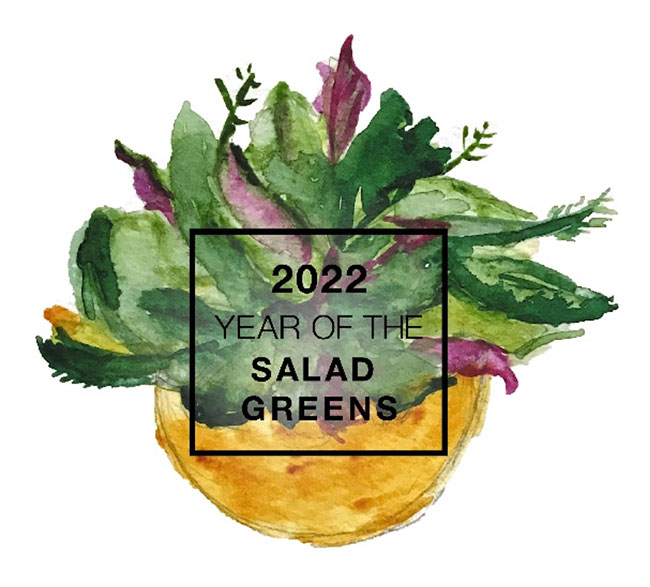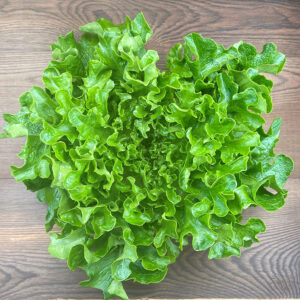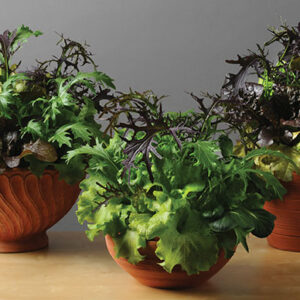
Features
Crops
Retail
Trends
2022 is the Year of the Salad Greens
Consumers have taken an increasing interest in their health during recent years. With the pandemic and new year’s resolutions in tow, it’s the perfect opportunity to explore salad greens as a potential new offering.
March 14, 2022 By Diane Blazek

For 2022, the edible in the spotlight is Salad Greens. Is it any wonder?
According to a 2021 survey, 73 per cent of consumers are dedicating themselves to a healthier diet after gaining what has been dubbed “The Quarantine 15,” meaning the 15 pounds they gained during COVID. Among those surveyed, a full 34 per cent say they try to make salad a part of their daily intake in hopes of reaching the recommended amount of fruits and vegetables.
Is there any easier way to sell more plants? With many greens only needing 40 to 70 days to reach maturity, and even fewer for baby greens, this edible has one of the quickest turn-around times. Transplants or larger “bowls” of greens can be a great impulse buy for customers who may like the idea of growing their own healthy salad. Educating your customers on succession planting will keep them coming back for more.
With so many types of salad greens to choose from, you can educate and cater to every personality and taste:
- Asteraceae family: Lettuce, Chicory, Dandelion greens
- Amaranthaceae family: Spinach, Chard, Beets Tops
- Brassicaceae family: Arugula, Kale, Mustard Greens, Turnip Tops
- Other: Asian Greens, Herbs
- A few varieties of note
- Cheap Frills Mix is a diverse, frilly mix that is a great introduction to different leaf types, and a visual stunner with beautiful red and green colour variations.
- Oceanside is a dark green spinach featuring nice thick leaves with a round/oval shape and versatile enough to be used for baby leaf or full-size leaves.
- Ezpark, part of the Eazyleaf series, is a vibrant green incised tango. An excellent choice for all seasons, Ezpark grows well and features impressive yield and uniformity.
- Marciano is a compact red butterhead with nice buttery leaves that showcase a deep burgundy exterior surrounding a well-filled interior of fresh bright green leaves.
- Jara is a dark green romaine that produces beautiful compact heads and is slow to bolt in the heat.
- Eliance is a heat-tolerant, smooth-leaved, self-bleaching escarole (endive). It is an easy-to-grow introduction to chicories, offering high yield and tender leaves.
- Redbor is a tall kale with impressive deep purple colour. A vigorous grower with deeply serrated leaves and sturdy stems, Redbor is an excellent choice, especially for cooler climates, as its colour strengthens and flavour sweetens with looming frost. Beyond the salad bowl, Redbor makes a great garnish or addition to floral arrangements.
How to Grow Salad Greens
According to National Garden Bureau (NGB) members, Johnny’s Selected Seeds and PanAmerican Seed, greens are quick, easy crops that can be produced year-round.
These plants can be grown during shoulder seasons, when traditional vegetable starts such as tomatoes and peppers may not be in-season.
Many types are best grown in the cool weather of spring and fall, and in the winter. Depending on your climate, greens can be grown in an unheated or minimally heated greenhouse. There are certain greens that thrive in warmer conditions so make sure you are choosing the correct type for the time of the year.
For most red and green leaf lettuces, along with Asian greens, follow these general plug production guidelines:
- Grow in partial sun or sunny conditions
- Recommended for 128-cell plug trays
- Plug crop time is 2 to 3 weeks
- Days to germination is usually 2 to 3 days
- pH for germination is 5.8-6.2 pH
- Lightly cover seed
Here are some general guidelines based on several varieties from PanAmerican Seed. This may vary for different crops.
- Stage 1: moisture level 4; temperature between 18-23 °C (65-73 °F); light is optional; fertilizer is less than 100 ppm N
- Stage 2: moisture level 3-4; temperature between 20-21 °C (68-70 °F); light is 1,000-2,500 f.c.; fertilizer is less than 100ppm N
- Stage 3: moisture level 2-3, temperature between 18-21 °C (65-70 °F); light is 1,000-2,5000 f.c.; fertilizer is between 100-175 ppm N
- Stage 4: moisture level 2-3; temperature between 17-18 °C (62-64 ° F); light is 2,500-5,000 f.c./ fertilizer is 100-175 ppm N
Note: total crop time can be reduced by one week by directly sowing into the final container.
If growing to finish, daytime temperatures should be between 17-21 °C (62-70 °F) and nighttime temperatures should be between 13-16 °C (56-61 °F). Media pH should fall between 5.8-6.2. Fertilize with less than 100 ppm N.
These are general guidelines, and it is recommended that growers conduct their own trials of various varieties under their own production conditions. Crop times can vary depending on climate, location, time of year and greenhouse environmental conditions.
‘Year Of’ Program
NGB does extensive work creating marketing content, which can help you save time and money, especially during the busy spring season!
NGB members provide numerous photos of varieties that are posted on the NGB website for use by industry growers, brokers and retailers. Fact sheets, flyers, handouts, signage, posters, and social media graphics can also be downloaded for use at no charge.
Growers, brokers and garden centres can take advantage of the publicity from this program and use the marketing collateral in their 2022 catalogues, websites, advertisements, presentations, trade show booths, event exhibits and other materials.
Stay tuned to this space when we introduce the ‘Year of’ bulb for 2022.
Diane Blazek is executive director of All-America Selections and National Garden Bureau. Find out more at ngb.org.
Print this page

